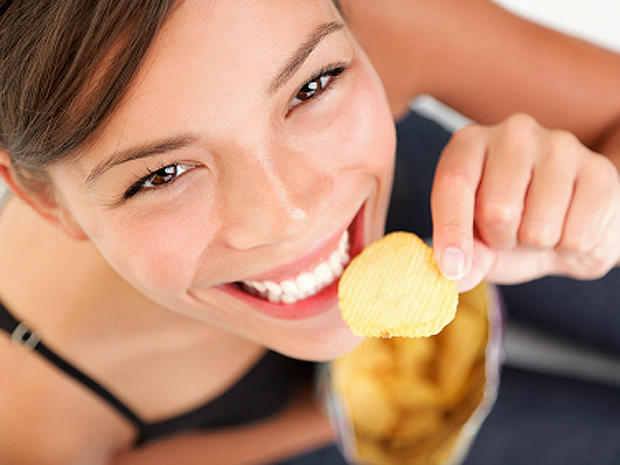Americans getting too much sodium, but not from salty snacks
(CBS/AP) Americans get too much sodium, according to a new government report. That fact may not come as a shock to a fast food nation, but what's surprising is where the sodium comes from.
For the report - released Feb. 7 - the Centers for Disease Control and Prevention compiled a list of the top 10 sources of sodium in the U.S. diet. These 10 foods were found responsible for 44 percent of all sodium consumed, reported.
But salty snacks, such as potato chips, were last on the list.
"Potato chips, pretzels, and popcorn - which we think of as the saltiest foods in our diet - are only No. 10," said CDC Director Dr. Thomas Frieden.
If not salty snacks, then what was the biggest contributor of sodium? Bread and rolls - accounting for twice as much sodium as salty junk food.
Breads and rolls aren't really saltier than many of the other foods, but people tend to eat a lot of them, said Mary Cogswell, a CDC senior scientist who co-authored the report.
Registered dietitian Amy Jamieson-Petonic, director of wellness coaching at Cleveland Clinic and spokesperson for the Academy of Nutrition and Dietetics, told HealthPop that she recommends opting for breads with "low sodium" on the label, and avoiding salty meats in sandwiches.
Salt is the main source of sodium for most people, and sodium increases the risk for high blood pressure, a major cause of heart disease and stroke. Health officials say most Americans get too much salt, mostly from processed and restaurant foods - not added from the salt shaker.
Dietary guidelines recommend no more than 2,300 milligrams of sodium a day, equal to about a teaspoon of salt. Certain people, such as those with high blood pressure, should eat even less. But average sodium consumption in the U.S. is around 3,300 milligrams, the CDC study found. Only 1 in 10 Americans meet the teaspoon guideline.
"It's possible to eat a whole bunch of sodium without it seeming salty," John Hayes, an assistant professor of food science at Penn State, said.
Other items on the list include soups, pizza, cold cuts and cured meats, and pasta dishes.
The amount of sodium in food types can vary. For example, a slice of white bread can have between 80 and 230 milligrams of sodium. A cup of canned chicken noodle soup has between 100 and 940 milligram. A small 1 ounce bag of potato chips ranges from 50 to 200 milligrams.
The new CDC report is based on surveys of more than 7,200 people in 2007 and 2008, including nearly 3,000 children. Participants were surveyed twice, each time answering detailed questions about what they had eaten over the previous day.
What should people do to cut their sodium intake?
"Cooking fresh food at home is the best way to lower sodium," Samantha Heller, a dietitian and clinical nutrition coordinator at the Center for Cancer Care at Griffin Hospital in Derby, Conn., told HealthDay.
CDC officials - who have long encouraged people to eat more fruits and vegetables - stopped short of advising people to lay off the bread. But they are encouraging consumers to read labels.
"People can choose how much salt to add to their food at the table," Frieden said. "They can't take it out once it's there."
What are the 10 foods that contribute to 44 percent of our sodium intake?
